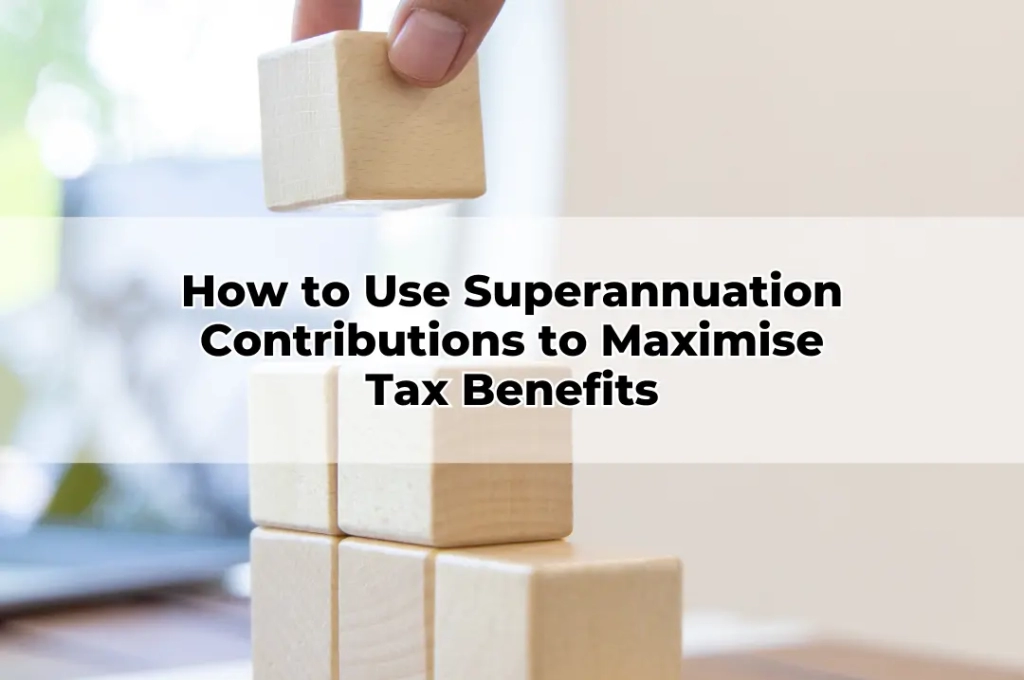How to Use Superannuation Contributions to Maximise Tax Benefits
Table of Contents
ToggleSuperannuation is more than just a retirement savings vehicle – it’s a potent mechanism for tax efficiency. With Australia’s robust regulatory structure, individuals can leverage strategic super contributions to mitigate tax liabilities while bolstering long-term financial security. For individuals seeking intelligent wealth structuring, understanding the nuances of concessional and non-concessional contributions is indispensable. As a Toowoomba Financial Adviser, I see many clients overlook the compounding advantages of early and consistent super contribution strategies.
The Different Types of Superannuation Contributions
Super contributions come in two primary forms: concessional (before-tax) and non-concessional (after-tax). Concessional contributions include employer Superannuation Guarantee (SG) payments, salary sacrifice arrangements, and personal deductible contributions. They are taxed at a concessional rate of 15%, typically lower than marginal tax rates.
Non-concessional contributions, made from after-tax income, aren’t taxed within the fund but are capped annually. These contributions can also include government co-contributions, spouse contributions, and downsizer contributions for eligible individuals. Understanding the cap thresholds, eligibility criteria, and carry-forward provisions is crucial for effective Financial Planning in Toowoomba and beyond.
Concessional Contributions: The Tax-Smart Strategy
Concessional contributions allow individuals to reduce their assessable income while building their super balance. With a current annual cap of $27,500, these contributions can lower taxable income, especially for those in higher marginal tax brackets.
For example, redirecting part of your salary through a structured salary sacrifice agreement reduces your PAYG liability while allocating funds into a tax-advantaged environment. It’s an intelligent move for those aiming to reduce immediate tax while investing in their future.
Be mindful: contributions over the cap are subject to additional tax, which can erode potential savings. Regular reviews with an Online Financial Adviser ensure compliance with changing thresholds and optimise timing.
Non-Concessional Contributions: Supercharging the Balance
Non-concessional contributions are ideal for high-income earners who have maxed out their concessional caps but wish to boost their retirement corpus. The standard annual cap is $110,000, with the ability to bring forward up to three years’ worth of contributions (totalling $330,000) under the bring-forward rule if under age 75 and eligible.
These contributions don’t reduce your taxable income directly, but they can grow in a tax-effective environment – with earnings taxed at 15% or 0% in the pension phase. For those seeking sophisticated wealth structuring, especially in pre-retirement years, this strategy aligns with broader financial planning goals.
The Bring-Forward Rule: Timing is Everything
The bring-forward rule allows eligible individuals to contribute up to three years’ worth of non-concessional contributions in one financial year. This strategy is advantageous for windfalls, inheritance, or downsizing the family home.
However, it’s crucial to understand that triggering this rule locks out future contributions for up to three years, depending on how much is contributed. Moreover, total super balance thresholds can restrict eligibility. Staying attuned to these dynamic rules is essential for anyone engaging in Retirement Financial Advice.
Carry-Forward Unused Concessional Contributions
Introduced to assist those with fluctuating incomes or irregular contribution patterns, the carry-forward rule allows you to access unused concessional contribution cap amounts from the previous five years (starting 1 July 2018), provided your total super balance is under $500,000.
This approach offers a retroactive advantage, especially for small business owners, part-time workers, or those who experienced employment interruptions. It provides the flexibility to catch up on contributions in years of higher income and enjoy greater tax deductions – a prudent tactic embraced by savvy investors across Toowoomba.
Salary Sacrificing: Boost Super While Cutting Tax
Salary sacrificing into super is a strategic way to divert pre-tax income into your superannuation fund, often reducing your taxable income and resulting in a lower overall tax bill.
By voluntarily redirecting a portion of your salary into super, contributions are taxed at just 15% (or 30% for high-income earners), which can be significantly lower than your marginal tax rate. This method is popular among mid-to-high-income earners seeking a balance between immediate tax relief and long-term wealth creation.
Ensure that the total of your salary sacrifice and employer SG contributions stay within the concessional cap to avoid excess contribution penalties. It’s a move that requires precision – and one best implemented with a Financial Adviser in Toowoomba to maximise its benefit.
Personal Deductible Contributions: Flexibility for the Self-Employed
Since the 2017 reforms, personal contributions are no longer limited to self-employed individuals. Now, anyone under age 75 (subject to work tests if over 67) can make personal contributions and claim them as a tax deduction.
This flexibility has opened the door for many Australians to align their tax planning and super strategies. Whether you’re a contractor, small business owner, or between jobs, making deductible personal contributions allows you to manage your income tax exposure while investing for retirement.
Before claiming, a Notice of Intent to Claim must be lodged with your super fund, and timing is critical. Getting it wrong can invalidate your deduction – highlighting the importance of expert guidance from an Online Financial Adviser.
Downsizer Contributions: A Smart Move Later in Life
For Australians aged 55 and over, downsizer contributions allow up to $300,000 per individual (or $600,000 per couple) to be contributed to super from the sale of a principal residence owned for at least 10 years.
These contributions do not count towards non-concessional caps and are not subject to total super balance limits. They offer an opportunity to free up capital, reduce tax, and potentially boost age pension eligibility through clever structuring.
It’s an often underutilised pathway to increase retirement funds in a tax-effective manner. However, eligibility conditions are strict, and timing requirements apply. As a trusted provider of Retirement Financial Advice in Toowoomba, I guide many clients through this transition.
Government Co-Contributions: Amplify Modest Contributions
For low- to middle-income earners, the government co-contribution scheme provides a valuable incentive. When eligible individuals make personal non-concessional contributions, the government may match it with up to $500 per financial year.
To qualify, you must have assessable income below the threshold ($58,445 for 2024-25), be under age 71, and meet work and residency conditions. While modest in dollar terms, this benefit represents a 50% return on a $1,000 contribution – outperforming most traditional investments.
These incentives highlight how superannuation strategy isn’t only for the wealthy. For clients seeking Financial Planning in Toowoomba, this scheme provides a foundational boost for long-term compounding returns.
Spouse Contributions and Tax Offsets
Contributing to your spouse’s super can yield a tax offset of up to $540 if your spouse earns less than $37,000 annually. It also helps balance retirement savings across a couple – a consideration that’s increasingly important under the Transfer Balance Cap regime.
This strategy is ideal for couples where one partner has stepped back from full-time work, such as during childcare years or pre-retirement transitions. The receiving spouse benefits from additional retirement savings, while the contributing spouse enjoys a direct tax benefit.
Implemented effectively, spouse contributions enhance household financial resilience and reduce future income stream disparities – a hallmark of holistic retirement planning.
Tax on Superannuation Contributions: Know the Limits
While super offers a concessional tax environment, it’s not tax-free. Concessional contributions are taxed at 15%, but higher-income earners may incur an additional 15% Division 293 tax if their income exceeds $250,000.
Non-concessional contributions aren’t taxed on entry, but exceeding the cap can lead to penalty tax rates of up to 47%. Additionally, if you fail to lodge a Notice of Intent correctly, you could miss out on valuable deductions.
Being aware of these tax implications ensures your strategy doesn’t backfire. A professional Toowoomba Financial Adviser ensures compliance with cap rules, tax thresholds, and lodgement timelines – turning complexity into opportunity.
Integrating Superannuation Contributions into Broader Tax Planning
Strategic super contributions should never occur in isolation. They must form part of a comprehensive tax plan aligned with income, investment strategy, business interests, and estate planning.
Contribution timing, asset allocation within the fund, pension conversion, and cap management all play a role in determining the optimal tax outcome. This requires foresight, adaptability, and ongoing financial governance – especially in today’s evolving legislative environment.
Clients who engage in proactive Financial Planning in Toowoomba benefit from bespoke strategies that use super not only as a retirement tool but as a multifaceted tax management instrument.
Conclusion
Maximising the tax benefits of superannuation contributions requires more than an annual deposit – it demands a calculated and dynamic strategy. The interplay of concessional and non-concessional contributions, coupled with government incentives and age-specific opportunities, forms a sophisticated tapestry of possibilities.
Whether you’re building wealth, transitioning to retirement, or managing legacy planning, the right contribution strategy can significantly reduce your tax burden while securing your future.
If you’re seeking a seasoned expert to help optimise your superannuation strategy, reach out to Wealth Factory today. As a Master Financial Planning and SMSF Specialist Advisor based in Toowoomba, I provide personalised advice tailored to your goals.
Let’s ensure your superannuation is working just as hard as you are.









